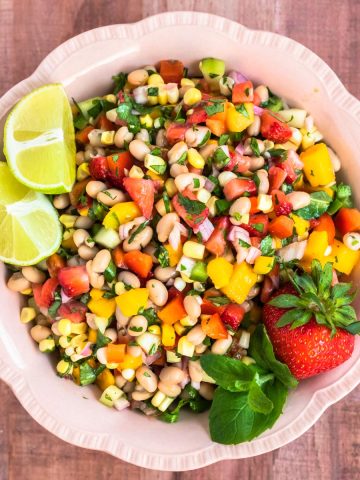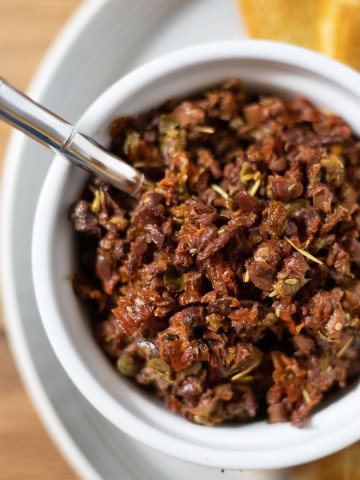This creamy, garlicky white bean hummus with herb salsa is a bright, healthy dip that goes with and on so many things, you’ll wonder how you got by without it until now!

For many years, I thought of hummus as simply the “healthy” option in a sea of cheese and cracker platters at dinner parties. That changed for me this past summer while on vacation in Hawaii, which just might be the strangest place ever to have an epiphany about hummus. Faced with a dearth of available restaurant reservations for parties of eleven (thank you, Covid), our family took an inspired leap and hired a private chef, Eden Edmisson, to deliver dinner to our timeshare. Eden’s specialty is Israeli cuisine, and the meal she prepared rocked my culinary world.
The cornerstone of our Israeli meal was Eden’s pitch-perfect hummus. It was almost melt-in-your-mouth creamy, and the flavor was balanced perfectly on the edge of rich and bright. It was 100 times better than any hummus I had ever had from a store. We scooped hummus with Eden’s freshly baked Israeli bread, we topped it with corn salad, we topped it with carrot salad, we spiced it up with schug (Israeli hot sauce), and we used it as a base for the entrees. It went with just about everything, and we couldn’t get enough.
An appetizer? A condiment? Yes!
Since then, I’ve been on a mission to master hummus. Homemade hummus is not only delicious and healthy, it’s way more versatile than I ever imagined. This white bean hummus has become a staple in my kitchen the past few months, and has officially entered the rotation of appetizers I regularly bring to dinner parties. My favorite way to eat it is still to scoop it with grilled whole wheat pita bread, chips, or veggies, but I’ve had fun finding other ways to use it too, including:
- Spread on whole wheat toast and topped with tomatoes, cucumbers, and feta
- Stuffed in a baked potato and topped with leftover roasted vegetables
- As a base in a Greek salad-stuffed pita pocket
- As a condiment for chicken shawarma (sometimes also stuffed in a pita pocket!)
How to make incredible white bean hummus
Achieving the perfect white bean hummus takes a combination of quality ingredients and the fearless use of a food processor. You want a texture that is thinner than peanut butter but thicker than Yoplait yogurt. It should barely resist when you scoop it, but it shouldn’t be so thin that it slides off a spoon. Here are some tips to get it just right:
Choose high quality canned beans. I do love traditional chickpea hummus, but I’ve veered toward using white beans more often partly because I find them easier to digest, and partly because (in my opinion) chickpeas need additional cooking and peeling to make a truly creamy hummus. Thankfully, quality canned white beans are widely available. Look for Cento or Bush’s cannellini or white kidney beans.
Track down tahini. Tahini, which is a paste made from roasted sesame seeds, gives hummus its silky texture and delightful nutty flavor, but it can be hard to locate in the grocery store. It might be by the peanut butter, or in the Indian food section, the Kosher food section, or a generic ethnic food aisle. If you can’t find it in the store you can order my favorite, Soom Premium Tahini, from Amazon.
Add water and blend, blend, blend! I’ve started you off with dependable proportions of beans, tahini, and garlic, but canned beans do vary in texture and water content, so you might need to add a little water to achieve the perfect consistency. It is possible to add too much water, so add it one or two teaspoons at a time, and stop your food processor in between to test it before adding more. You’ll also want to blend it for what will feel like a long time...a solid four or five minutes.
Dress it up with garnish
White bean hummus is delicious simply drizzled with quality olive oil and sprinkled with cumin or sumac, but it is spectacular and can be downright elegant with the right garnishes. I’ve chosen two here...herb salsa and spiced pine nuts...but the possibilities are truly endless. You can also top it off with my olive and sundried tomato tapenade, which is absolutely delicious!
Hummus will keep in an airtight container in your refrigerator for 3-4 days.
White Bean Hummus with Herb Salsa and Spiced Pine Nuts
Equipment
- Microwave
- Blender
Ingredients
- 2-3 cloves garlic
- 1 can white cannellini beans, drained and rinsed 14 ounces
- ½ cup tahini stirred well
- ½ teaspoon kosher salt more to taste
- ½ teaspoon sumac optional
- 2 tablespoons fresh squeezed lemon juice or white verjuice
- 2 tablespoons extra virgin olive oil
For the herb salsa
- 2 cups mixed fresh herbs (parsley, mint, basil, cilantro) washed and dried
- 1 teaspoon red or white wine vinegar
- 2 tablespoons extra virgin olive oil
- 1 pinch kosher salt
For the spiced pine nuts
- 2 tablespoons pine nuts
- ¼ teaspoon extra virgin olive oil
- ½ teaspoon Israeli spice mix or Za'atar
Instructions
- Place the garlic in a microwave-safe bowl and cover loosely with a paper towel. Microwave for 30 seconds. Set aside and allow to cool before slipping off the skins and trimming off the woody end.
- Prepare the herb salsa. In a blender or smoothie cup, add the herbs, olive oil, vinegar and salt. Blend until combined, 20-30 seconds. Add more olive oil as needed to make the salsa pourable. Taste and adjust salt, and set aside.
- Prepare the pine nuts. Toss them in a small bowl with a bit of olive oil and the spice mix. Add to a cold, dry skillet and place over medium heat. watching them carefully and shaking the pan occasionally as it heats up.
- Once the pine nuts begin to start browning, shake or stir every 15-20 seconds until they are toasted and you can smell the spices, usually 1-2 minutes. Watch carefully so they don't burn. Remove from heat and transfer to a bowl as soon as they look toasty and brown.
- Add the beans, garlic, salt, sumac, and lemon juice or verjuice to the food processor and blend for 30 seconds.
- Add the tahini to the food processor and blend for 4 to 5 minutes, stopping several times to check for consistency. Add 1 to 2 teaspoons of water each time if your hummus seems too thick. Be careful not too add too much water.
- The last time you stop the food processor to check for consistency, taste for and adjust the salt and lemon juice/verjuice if needed. The hummus should be neither salty nor lemony, you are looking for a balance between rich and bright. Be careful not to add to much salt or lemon juice when you are adjusting, add a little at a time, and taste often.
- Transfer hummus to a bowl. Drizzle with olive oil and a swirl of herb salsa. Top with pine nuts and serve with grilled whole wheat pita bread and/or vegetables.
Notes
Need more servings?
To adjust a recipe for more or fewer servings, hover your cursor over the number servings on the recipe card. This will bring up a slider that you can move to the number of servings you want to make.
Nutrition







Steph S says
What if you don't have a microwave? (for the garlic)
Lisa says
Hi Steph! If you don't have a microwave, you can add the garlic raw, or toss it with a little olive oil, wrap it in foil, and roast it in a 375 degree oven for 15-20 minutes. Cooking it a little mellows the flavor a touch, but it's not necessary for garlic lovers. Let me know if you have any other questions!
Lisa says
You can also poach a couple of cloves of garlic in olive oil over medium low heat until they are soft. Cool them before adding to the hummus. You can also cool the olive oil you used for poaching and use it in both the hummus and the herb salsa.
Jennifer says
I made this to bring to two holiday parties last weekend. It was fresh and delicious! The herb salsa is the best part of the whole recipe. I loved having something bright and healthy to contrast so much decadence we expect during the month of December!
Lisa says
Thanks Jennifer...the herb salsa is my favorite part too...and good on just about anything, not just hummus!